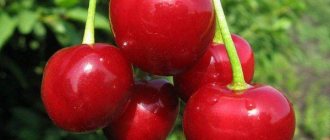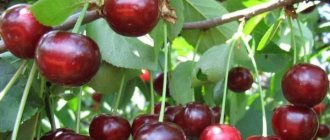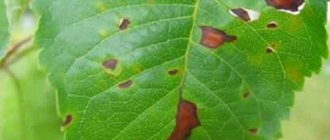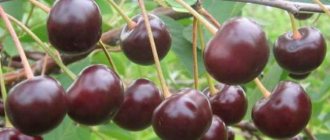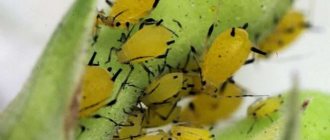Description
This plant variety is one of the most beautiful and rare. This is due to the fact that its flowers have the ability to change their color depending on growing conditions.
History of the variety, who bred it
Frosty cherry was bred in 2005 by the famous breeder Konstantin Morev. In order to achieve perfection, he worked on creating this uniquely beautiful variety for more than 11 years.
Leaves
The Frost Cherry rosette consists of pointed, simple, oval, standard-sized leaves. The leaf blade is covered with delicate villi. As for the color of the leaves, it changes with age: young leaves are painted a soft green color, and as they get older, their color gradually changes to dark green.
Flowers
The real decoration of violets of the Frosty Cherry variety are their beautiful flowers. Their diameter ranges from 4 to 5 mm. If the plant blooms for the first year, its flowers are smaller. In the second and third years of flowering it increases. The petals have a terry covering.
The color scheme is based on a rich cherry color, along the edge of which there is a wide white stripe. The central part of the flower is white. In the central part of the flower there are yellow stamens.
Differences from other varieties
A distinctive feature of the Frosty Cherry variety violet is that over time the color of the petals tends to change: sometimes it becomes saturated, sometimes it fades.
The change in color depends on many factors, for example, on the temperature of the room where the container with the plant is located: when the temperature rises, the color of the petals becomes deep red, and when the air temperature drops, the petals become pale pink.
Among the factors influencing the color intensity are also the flowering period of the plant, stability and level of lighting, and time of year.
It is also worth noting that the flowering period of violets of this variety begins quite early.
Problems when growing violets Frosty cherry
Violation of the temperature regime, significant moisture, watering from the tap and uncontrolled lighting can cause plant disease. The main problems associated with improper care and ways to solve them are shown in the table.
| Problem | Cause, manifestations | Corrective measures |
| Late blight | Brown spots appear on the leaves, which then increase in size. Initially, the lesion affects the old, lower plates. As a result of the disease, the plant withers. | The soil and lower crown must be thrown away. For prevention, neighboring plants should be treated even if there are no signs of damage. |
| Powdery mildew | The defect occurs due to fungal spores transferred from infected specimens. When infected, the leaf becomes sloppy and a white, indelible layer forms on it. Ulcers may appear on the plates or die off. | It is necessary to tear off flower stalks, as well as damaged leaves. In the early stages, spraying with preparations such as Topaz, Sapropel, soda (4 g per 1 liter of water) or dusting with sulfur powder is performed, and in the later stages Bayleton will help out. Repeated treatment is done after 7 days. |
| Rust | First, a brown coating is detected on the bush, after which the leaves become deformed. The problem usually occurs due to overwatering of the plant. | It is necessary to stop introducing liquid into the soil for a while. Treat the leaves with a rust preventative. |
| Fusarium | An insidious disease that affects the roots. Rotting is transmitted to the trunk and leaves. Risk factors are the flowering period and temperatures below +16 °C. | For prevention, it is important to maintain suitable environmental conditions and water with warm water. The affected specimen cannot be saved - the violet is destroyed. |
| Gray rot | The problem arises due to spraying carried out by an inexperienced owner. As a result, mold forms on the flowers and plates. | Damaged parts of the plant should be removed, the room where the bush is located should be ventilated, treated with a fungicide and watering reduced. |
Photo of the variety “Frosty Cherry”
Growing conditions
Violet Frosty cherry is a light- and heat-loving plant. In order to achieve the flowering characteristic of plants of this variety, it is necessary to observe certain growing conditions.
Priming
To grow violets, it is recommended to use special soil, which can be purchased at a flower shop. But you can prepare the soil yourself. To do this, you need to use the following components:
- turf soil;
- peat;
- leaf soil;
- needles;
- raising agents.
If we are talking about soil that is used for rooting cuttings, to prepare it, you can mix equal parts cultivator and peat.
Pot
To grow violets, it is better to use small plastic containers. Plants do not like large diameter pots. This is due to the fact that its roots are located in the upper part of the soil. It is necessary to make small holes in the bottom of the container to allow excess liquid to drain.
Important! If there are no such holes, it is possible that excess moisture will accumulate in the soil, which will lead to rotting of the root system.
Lighting
Frosty cherry is a light-loving plant: its daylight hours should not be less than 12 hours. In winter and autumn, plants need additional lighting.
If the violet does not receive enough light, its leaves gradually droop down. When direct rays of the sun hit the leaf blades, burns will form on them, which will appear in the video of brown spots.
The shape of the Frosty Cherry bush also depends on the amount of incoming light. When there is insufficient lighting, the cuttings of the leaves are stretched and turned towards the light. If there is excess lighting, they are located closer to the central part of the outlet.
Temperature
This variety of violet is extremely demanding on temperature conditions. For growth and development, this figure can be within 10 – 16 degrees. For the active flowering period to begin, the room temperature should be from 20 to 26 degrees.
Important! If the temperature drops to 5 or rises above 30 degrees, the plant will simply die!
There should be no drafts in the place where the pots with violets are located. This has a negative effect on Frost Cherry blossoms.
Humidity
The watering regime is no less important for violets. When overwatering, there is a high probability of death of the entire plant. If the soil ball is dry, this affects the appearance of the leaves: they wither and droop.
As for the water temperature, it should not be cold. The most optimal water for watering Frosty cherries is considered to be at room temperature.
It is necessary to water the soil along the edge of the pot. Excess liquid will flow out through the holes in the container and remain in the pan. 1 - 2 hours after watering, excess water from the pan must be drained, preventing it from stagnating.
Useful properties and uses of violets
This indoor plant not only pleases household members with its beautiful flowering. Violet is actively used in folk medicine. It has anti-inflammatory, laxative and diuretic effects. Violet herb helps with bronchitis, sore throat, whooping cough, headaches, migraines. A decoction based on violet herb can be used for external and internal use. An infusion of violet flowers is used for convulsions, epilepsy, and tinnitus.
Popular folk recipes from violet leaves and flowers:
- For sore throat. Pour 50 g of plant flowers into 200 ml of alcohol. Close the lid and leave to infuse for 7 days. The prepared tincture is taken 30 ml before meals 3 times a day. To achieve an effective result, you can gargle with this tincture.
- When coughing. Take dried violet leaves and flowers in equal quantities, about 50 g. Next, pour a glass of hot water and leave to steep for a day. Then strain, heat slightly over low heat and sweeten. Take a teaspoon 4 times a day. The duration of treatment is about 7 days.
- For insomnia. Take 3-4 grams of flowers and pour boiled milk (200 ml). Leave in this state for 30 minutes. The prepared composition should be drunk before bed and the flowers should be eaten.
It is recommended to add violet decoction to bathing water for babies. With regular use, it helps cure rickets, eczema, scrofula and skin rashes. When using violet to treat various diseases, remember that the plant is poisonous. It is recommended to consult a doctor before using decoctions and infusions based on violet leaves and flowers.
Video about the flowering of the violet “Frosty Cherry”:
If you place a blooming Saintpaulia of this variety in an area with less light, then the petals of the violet variety Winter Cherry will begin to lighten. Indoor flowers of the Frost Cherry species prefer warm climates, because their ancestors come from West Africa, but do not tolerate high temperatures combined with high humidity. In the cold, the intensity of the shade becomes weaker.
If the temperature outside the window is low, white color predominates in the flowers, and in the heat red dominates, to the point that the white areas on the petals of Saintpaulia may completely disappear. The flowers of this variety are large in size, but this feature is noticeable from the second and subsequent blooms. It may seem that plants of this variety bloom better when lit by a candle, but this is most likely a subjective feeling.
As for the leaves, in young plants they are a little lighter than in mature Saintpaulias. It should be noted that at various exhibitions of indoor flowers, violets of the Frosty cherry variety are always popular among visitors because of their bright and rich color.
Planting and propagation
To preserve maternal characteristics, Frosty cherry is recommended to be propagated by cuttings. To do this, a healthy and durable leaf is cut off at the root. Then it is placed in a cool place (refrigerator) for 2 - 3 hours. During this time, you can prepare the pot and container.
The diameter of the planting container should not be more than 6 cm. This promotes active growth of the root system.
It is better to prepare the soil mixture yourself by mixing garden soil, peat and sand (3: 3: 1).
The cutting goes deep into the soil to a depth of 2 - 2.5 cm. After this, the sheet is covered with a glass jar. After 30 - 40 days, the first cutting will take root.
Care
For normal growth and development of the “Frosty Cherry”, it needs to be provided with certain care. Otherwise, the plant will grow slowly and the flowering period may not occur.
Watering
The plant does not tolerate waterlogged soil and drought. It is recommended to water violets as the soil dries. Excess liquid, which is removed through the drainage holes, is removed after each watering.
Transfer
An adult plant must be replanted twice throughout the year. This must be done with a lump of old earth, carefully removing it from the old container.
If there are no signs of disease on the plant, the old soil is not replaced with new soil, but only added to a new pot of larger diameter.
If there is the slightest sign of disease, the old soil is carefully shaken off the root system. To disinfect the roots, I place them in a weak solution of potassium permanganate for 10–20 minutes.
How to form a bush correctly
For preventive pruning, old dried leaves and faded buds are removed.
Lateral layers—stepchildren—are also plucked to prevent thickening of the crown.
Adult, overgrown violets also need to form a bush.
Their lower leaves usually grow strongly on the sides, the peduncles become elongated, which spoils the overall impression of the appearance of the plant.
Complete pruning of the lower leaves can solve this problem. A rejuvenation method is also suitable, in which the upper rosette of the violet is cut and rooted in order to obtain a new plant.
Violets of the RM Royal Lace variety are one of the most beautiful representatives of their species. With proper care, they can become a worthy addition to the most sophisticated collections of these indoor plants.
It will be useful for owners of most popular varieties, for example Saintpaulia “Duchess”.
Fertilizer and feeding
This variety of violets does not respond well to dense and overly nutritious soils. This can lead to slower growth of the plant, loss of attractiveness, and stopping the flowering process.
As a top dressing, it is better to use special fertilizers, which can be purchased at flower shops. You should not fertilize Frosty cherry more than 1 - 2 times over 30 days.

